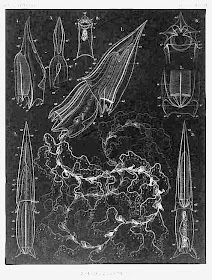These clear, gelatinous "blobs" were most often washed up singly (as below). They were about 3 cm (a little over an inch) long.
Rarely, I found two still attached:
You probably noticed that these animals actually have a recognizable shape — with a distinct point at one end, and a wider base at the opposite end.
Although they get a little "beat up" after going through the surf zone and being tossed onto the beach (their normal habitat is the open ocean), the rest of the animal is much easier to see when placed in a small aquarium (see below).
The "pointed blob" I showed above is the swimming bell (or nectophore) of a siphonophore called Diphyes dispar. Although not visible on the beach, in the aquarium you can see the siphonophore's tentacles. The tentacles can be retracted inside the bell, or extended for feeding. Compare the two photos below (this is the same individual).
Ernst Haeckel illustrated Diphyes dispar in 1888:
From: Haeckel, E. 1888. Report on the Siphonophorae - Scientific Results of
the Voyage of H.M.S. Challenger during the years 1873-76, Zoology 28:
1-380.
Why was this one of my favorite "blobs" from this summer/fall?
Well, first of all, I just love siphonophores. If you need an introduction to them, or a review, see the posts from 23 January 2012 and 3 April 2013.
Second: Siphonophores are challenging to identify, but I figured this one out and then received confirmation from Phil Pugh (Thanks, Phil!). I almost second-guessed myself, because this species is not known to be common in northern California, but the teeth at the base of the nectophore are distinctive (see microscope image below):
Third: As mentioned, Diphyes dispar is a southern species. The Light and Smith Manual (2007) says that it is, "More likely to be encountered in the southern range of this book [Point Conception], continuing down Baja California, but has worldwide distribution in warmer waters." It's rare for this siphonophore to be in northern California, and I will always remember it as a symbol of the warm water event we experienced in 2014.






Hooray for more blobs!
ReplyDelete